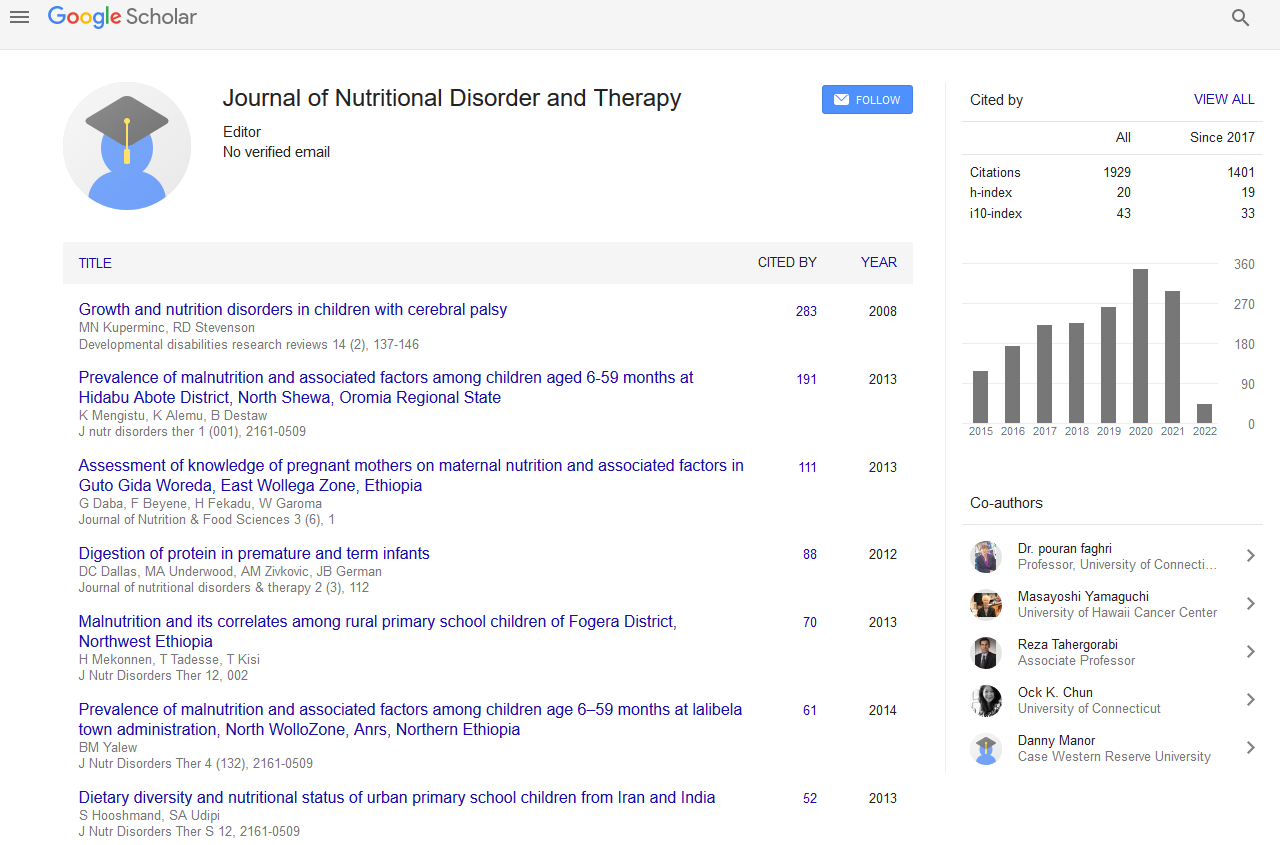Indexed In
- Open J Gate
- Genamics JournalSeek
- Academic Keys
- JournalTOCs
- Ulrich's Periodicals Directory
- RefSeek
- Hamdard University
- EBSCO A-Z
- OCLC- WorldCat
- Publons
- Geneva Foundation for Medical Education and Research
- Euro Pub
Useful Links
Share This Page
Journal Flyer

Open Access Journals
- Agri and Aquaculture
- Biochemistry
- Bioinformatics & Systems Biology
- Business & Management
- Chemistry
- Clinical Sciences
- Engineering
- Food & Nutrition
- General Science
- Genetics & Molecular Biology
- Immunology & Microbiology
- Medical Sciences
- Neuroscience & Psychology
- Nursing & Health Care
- Pharmaceutical Sciences
Exploring preventive strategies of childhood obesity through prenatal education
International Conference on Pediatric Nutrition
August 01-02, 2016 New Orleans, USA
Ann W Lambert and Chih-hsuan Wang
Auburn University, USA
Scientific Tracks Abstracts: J Nutr Disorders Ther
Abstract:
This project developed and evaluated a prenatal educational intervention designed to modify mothers�?? behaviors that may reduce the risk of childhood obesity in her offspring. We identified prenatal factors associated with early childhood obesity from a literature review and the focus group findings. The focus group reported poor food choices, lack of exercise, excess weight gain, gestational diabetes, smoking and bottle feeding as compared to breastfeeding as prenatal factors affecting childhood obesity. Physicians were also asked how to intervene with patients who have one or more risk factors. The focus group suggested verbal, written/brochure and video media for education. They also suggested referral to a specialist if needed. A survey was conducted to ascertain perceptions among regional obstetrical healthcare providers, including physicians and certified nurse midwives (CNM), related to preventing early childhood obesity. Healthcare providers, who participated in the survey, agreed that childhood obesity could be due to the parental diet choices and physical activity opportunities. Based on participants�?? responses of potential risk factors for childhood obesity, they believed that maternal diabetes, gestational diabetes, excess gestational weight gains, lacking awareness of appropriate weight gain during pregnancy, and high birth weight of the infant were major risk factors to childhood obesity. Some of them considered maternal malnutrition to be a risk factor, but some did not. These professionals did not consider smoking and alcohol as risk factors for childhood obesity. Most of them believed that breast-feeding could protect the infants from childhood obesity. Both physicians and CNMs had similar perceptions toward these risk factors. Physicians and midwives suggested the most feasible methods of education about prenatal factors and childhood obesity would be a brochure or verbal information. An evidence-based educational brochure and video were developed and delivered within the healthcare provider setting, including local Obstetrics offices and childbirth preparation classes. We evaluated the effectiveness of the intervention through our pilot study. Participants in the pilot study were 36 pregnant females aged from 17 to 40. The pre- and post-survey were administrated before and after presenting the educational materials, including oral, written and video. The results indicated that after receiving the educational materials, participants�?? knowledge about the risk factors related to childhood obesity during the prenatal stage was increased. However, their attitude did not change. As for the educational materials, most of them considered the video was the most useful, attractive and helpful. The second most useful, attractive and helpful method was the oral education. Only half of the women considered the written material as useful, attractive and helpful.
Biography :
Ann W Lambert completed her Masters degree in Maternal Child Nursing and is full time faculty at Auburn University School of Nursing with classroom and clinical responsibilities for Pediatric Nursing. She also maintains her practice as a Pediatric Nurse Practitioner in primary care. She has over 30 years experience in nursing and teaching nursing students. She has presented at the state level and poster presentations at the national level. She is involved in outreach projects related to childhood obesity, safe sleep and promoting breastfeeding.
Email: awl0011@auburn.edu


